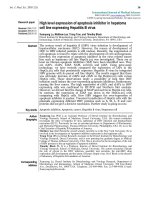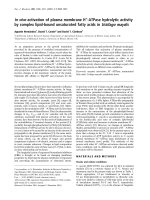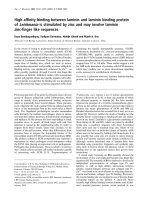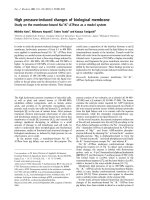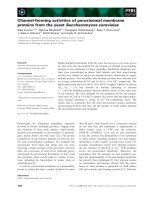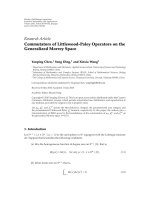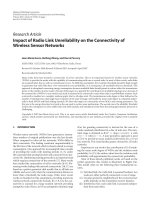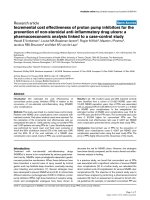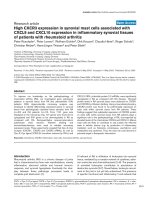Báo cáo Y học: High pressure-induced changes of biological membrane Study on the membrane-bound Na+/K+-ATPase as a model system pdf
Bạn đang xem bản rút gọn của tài liệu. Xem và tải ngay bản đầy đủ của tài liệu tại đây (435.39 KB, 9 trang )
High pressure-induced changes of biological membrane
Study on the membrane-bound Na
+
/K
+
-ATPase as a model system
Michiko Kato
1
, Rikimaru Hayashi
1
, Takeo Tsuda
2
and Kazuya Taniguchi
2
1
Division of Applied Life Sciences, Graduate School of Agriculture, Kyoto University, Japan;
2
Biological Chemistry,
Graduate School of Science, Hokkaido University, Kita-ku, Sapporo, Japan
In order to study the pressure-in duced changes of biological
membrane , hydros tatic pr essure s of from 0.1 t o 400 MPa
were applied to membrane-bound Na
+
/K
+
-ATPase f rom
pig k idney as a model system o f protein and lipid membrane.
The a ctivity showed at least a three-step change induced by
pressures of 0.1±100 MPa, 100±220 MPa, and 220 MPa or
higher. At p ressures o f 100 MPa or lower a decrease in t he
¯uidity of lipid bilayer a nd a reversible conformational
change in transmembrane protein is induced, leading to the
functional disorder o f membrane-associated ATPase activ-
ity. A pressure of 100±220 M Pa causes a reversible phase
transition in parts of the lipid bilayer from the liquid crys-
talline to the gel phase and the dissociation of and/or con-
formational c hanges in the protein subunits. T hese changes
could cause a separation o f t he interface between a and b
subunits and b etween protein a nd the lipid bilayer to c reate
transmembrane tunnels at the interface. Tunnels would be
®lled with w ater from the aqueous environment a nd tak e up
tritiated w ater. A pressure of 220 MPa or higher irreve rsibly
destroys and fragments the gross membrane structure, due
to protein unfolding and i nterface separation, which is am-
pli®ed by the i ncreased pressure. T hese ®ndings p rovide an
explanation for the high p ressure-induced membrane-dam-
age t o subcellular organelles.
Keywords: hydrostatic pressure; membrane; Na
+
/K
+
-
ATPase; h ydrogen±tritium exchange.
The high hydrostatic pressure treatment of microbial cells,
as well as plant and animal tissues at 100±400 MPa
solubilizes cellular components, such as metals, amino
acids, a nd proteins [ 1±5], permeates extracellular c om-
pounds, such as s alts, into cells and tissues [6,7], and lead to
hemolysis [8], in t he case of animal tissue. After pressure
treatment, electron m icroscopic observation o f yeast cells
and b iochemical analysis of animal tissues have shown that
membranes of nuclei [9], lysosomes [4,5], and vacuoles [9]
undergo signi®cant disrupting, in addition to a small
amount of damage to cell membranes and cell walls. In
order to understand these morphological and biochemical
phenomena, studies of functional and structural changes of
biological membranes, as induced by high pressure (in situ
observation), are in order.
In the present study, a membrane-bound Na
+
/K
+
-
ATPase from pig kidney was used for this purpo se. The
enzyme consists of two subunits, an a subunit ( M
r
94 000±
120 000) and a b subunit (M
r
40 000±57 000). The former
contains the catalytic center r equired for ATP hydrolysis
[10]. I n terms of gross structure, approximately t wo-thirds o f
the total enzyme protein (water soluble domain) protrudes
from the lipid bilayer and is in contact with the aqueous
environment, while the remainder (transmembrane seg-
ment) is surrounded by the lipid bilayer [ 11,12].
In the overall reaction, the enzyme t ransports sodium out
of the cell and potassium into the cell [10] according to the
Post±Albers mechanism a s f ollows: t he Na
+
-bound enzyme
(Na
+
-dependent ATPase) is phosphorylated by ATP in the
presence of Mg
2+
and f orms ADP-sensitive phospho-
enzyme followe d by releasing Na
+
to form the K
+
-sensitive
phospho-enzyme. This is dephosphorylated to form the
K
+
-bound enzym e (K
+
-activated phosphatase) and ®nally
the K
+
-bound enzyme accepts Na
+
and releases K
+
.
Na
+
/K
+
-ATPase undergoes conformational changes
during the reaction [11,13±16]. To d etect such conforma-
tional changes, t he enzyme is labeled with ¯uo rescence
probes, such as N-(p-(2-ben zimidazolyl)phenyl)maleimide
(BIPM) [17] and ¯uorescein 5 ¢-isothiocyanate (FITC) [ 18].
The former b inds to Cys964, which is located in the
transmembrane s egment [17], and the latter b inds to Lys501,
which is located in the water-soluble domain [19±21].
Moderately high pressures of u p to 200 MPa suppress
Na
+
/K
+
-ATPase activity b y d ecreasing m embrane ¯uidity,
which, in turn, hinders conformational transitions of the
protein [22,23]. These pressures also appear to dissociate
and/or unfold protein subunits of the enzyme [ 24].
In this study, p ressure-induced functional and structural
changes o f the membrane-bound Na
+
/K
+
-ATPase from
pig k idney have been studied in detail as a model system of
Correspondence to M. Kato, Division of Applied Life Sciences,
Graduate School of Agriculture, Kyoto University, Kyoto 606-8502,
Japan. Fax: + 81 75 75 3 6128, Tel.: + 81 75 753 6495,
E-mail: m
Abbreviations: FITC, ¯uorescein 5¢-isothiocyanate; BF/F, th e r atio of
FITC ¯uorescence emitted at the excitation wavelength for BIPM
(305 nm) to FITC ¯uorescence emitted at the excitation wavelength
for FITC (470 nm); BIPM, N-(p-(2-benzimidazolyl)phenyl)
maleimide; C
12
E
8
, octa-ethyleneglycol mono n-dodecyl ether; H±T
exchange, hydrogen±tritium exchange; pNPP, p-nitrophenylphos-
phate; soy-PtdCho, soybean phosphatidylcholine.
(Received 2 July 2001, revised 28 September 2001, accepted 2 3 October
2001)
Eur. J. Biochem. 269, 110±118 (2002) Ó FEBS 2002
the cell membrane consisting of lipid bilayer and trans-
membrane proteins.
EXPERIMENTAL PROCEDURES
Materials
ATP (Tris salt), pNPP (Tris salt), egg albumin and soy-
PtdCho were obtained from Sigma. Rabbit muscle pyruvate
kinase (a s alt-free lyophilized p owder of speci®c activity,
100±200 Uámg
)1
), bovine pancreatic trypsin (N-a-tosyl-
L
-
phenylalanylchloromethane treated, speci®c activity, 7 000±
13 000 Uámg
)1
for N-a-benzoyl-
L
-arginine ethylester), and
NADH were purchased from Nacalai T esque (Kyoto,
Japan). Chicken he art l actate dehydroge nase (lyophiliz ed
powder of speci®c activity, 300 Uámg
)1
or higher) and
phosphoenolpyruvate were obtained from Wako Pure
Chemicals ( Osaka, Japan). C
12
E
8
was purchased from
Nikko Chemicals (Tokyo, Japan). Tritiated water
(37 M BqámL
)1
) was purchased from Dupont. P ig kidney
Na
+
/K
+
-ATPase (speci®c activity, 1240 lmolámg pro-
tein
)1
áh
)1
), BIPM- [17] and FITC- [18] labeled enzymes,
and BIPM/FITC doubly l abeled enzyme were prepared by
Taniguchi, Graduate School of Science, Hokkaido Univer-
sity, according t o the method of Jùrgensen [11]. The buffer
used in the high pressure experiments were 40 m
M
Tris/HCl,
pH 7.4, to minimize the pressure-induced pH changes [25].
In situ
spectroscopic measurements under high pressure
Absorbance and ¯uorescence under high pressure were
measured using a Shimadzu UV-2500PC spectrophotome-
ter (Kyoto, Japan) and a Shimadzu RF-5300PC s pectro-
¯uorometer, respectively, equipped with a high pressure
photometer cell (Type PCI-400SRF; Teramex Co., Kyoto,
Japan), which contains three s apphire windows.
The enzyme was added to the reaction mixture, which
had been previously incubated at ambient pressure and at
37 °C, and a portion of the m ixture was placed in the high
pressure photometer cell, which was maintained at 37 °Cby
circulating water. Immediately a fter the cell was sealed,
pressure was applied with a hand-type pump (Type TP-500,
Teramex Co.) using water as the pressure medium. Typi-
cally, after 90 s (required to a ttain the des ired pressure),
spectroscopic changes were recorded.
Activity measurements
Three activities of N a
+
/K
+
-ATPase were determined a s
follows. Na
+
/K
+
-ATPase activity was measured by mon-
itoring the decrease in NADH absorbance at 340 nm
(e
340
6.2 2 ´ 10
3
M
)1
ácm
)1
) using a coupled enzyme assay
method [26]. The assay mixture contained 40 m
M
Tris/HCl,
pH 7.4, 160 m
M
NaCl, 16 m
M
KCl, 25 m
M
sucrose, 5 m
M
MgCl
2
,0.1m
M
EDTA, 4 m
M
ATP-Tris, 1 m
M
phosphoenolpyruvate, 0.3 m
M
NADH, 5 lgámL
)1
of p yru-
vate k inase, and 2.5 lgámL
)1
LDH i n a total v olume o f
2 m L. The reaction was initiated by an addition of 50 ng
of Na
+
/K
+
-ATPase. Na
+
-dependent ATPase activity
was also measured u sing the coupled enzyme assay meth-
od as described above except that 4 m
M
ATP-Tris and
16 m
M
KCl was replaced with 100 l
M
ATP-Tris and 16 m
M
choline chloride, respectively. It was already shown that
high concentration of Na
+
activates pyruvate kinase
without K
+
[27]. The reaction was initiated by an addition
of 1 lgenzyme.K
+
-activated phosphatase activity was
determined as K
+
-dependent pNPPase activity by measur-
ing the amount of p-nitrophenol (e
420
1.33 ´
10
4
M
)1
ácm
)1
) released from pNPP. The assay mixture
contained 40 m
M
Tris/HCl, pH 7.4, 4 m
M
pNPP-Tris,
16 m
M
KCl, 25 m
M
sucrose, 4 m
M
MgCl
2
,0.1m
M
EDTA
in a total volume of 2 mL. The reaction was initiated by the
addition of 2 lgenzyme.
Fluorescence measurements
Intrinsic ¯uorescence was monitored at 300±400 nm with an
excitation at 280 nm. The sa mple solution contained 10 lg
of Na
+
/K
+
-ATPase, 16 m
M
KCl and/or 16 m
M
NaCl,
25 m
M
Tris/HCl, pH 7.4, 0.43 m
M
MgCl
2
,25m
M
sucrose,
and 0.1 m
M
EDTA in a total volume of 2 mL. BIPM and
FITC ¯uorescences were monitored a t 330±560 nm with an
excitation at 305 nm and at 500±560 nm with an excitation
at 470 nm, respectively. The sample solution contained
10 lg of BIPM- or FITC-labeled enzyme, 160 m
M
NaCl or
16 m
M
KCl, 25 m
M
Tris/HCl, pH 7.4, 0.43 m
M
MgCl
2
,
25 m
M
sucrose, a nd 0.1 m
M
EDTA in a total volume of
2 m L. Fluorescence energy transfer was determined by
measuring the ratio of FITC ¯uorescence emitted as a result
of excitation at 305 nm to the FITC ¯uorescence emitted by
the excitation at 470 nm (BF/F). The sample solution
contained 10 lg of BIPM/FITC doubly labeled enzyme and
the other compounds as described above. All ¯uorescence
emission spectra were recorded after the sample solutions
had been maintained at various pressures and 37 °Cfor
15 min.
Preparation of solubilized Na
+
/K
+
-ATPase
Two milligrams per milliliter Na
+
/K
+
-ATPase was incu-
bated i n the solution containing 6 mgámL
)1
C
12
E
8
,0.05
M
KCl, 2 m
M
dithioerythritol, 10% (w/v) glycerol, 13 m
M
imidazole, and 8 m
M
Hepes, pH 7.0, in a total volume of
2mLat0°C for 5 min [28]. The solution was centrifuged at
170 000 g and 0 °C for 20 min. The supernatant was
collected and i s hereafter re ferred t o as t he solubilized
Na
+
/K
+
-ATPase,whichretained30%oftheoriginal
activity.
Tritium±hydrogen exchange
Twenty microliters (100 lg) of Na
+
/K
+
-ATPase were
mixedwith100lL of tritiated water (3.7 MBqámL
)1
)and
120 lLof40m
M
Tris/HCl buffer, pH 7.5, and a 240-lL
aliquot of the mixture was p laced in a small plastic tube
(4 mm internal diameter ´ 19 mm) and the tube covered
with a polyethylene-based stretch ®lm obtained f rom T oho
Co. (Tokyo, Japan), after carefully removing the air bubble
in the headspace. The sealed tube was placed in the h igh-
pressure vessel and pressurized at 37 °Cfor15min.After
the release of the pressure, a 200-lL aliquot of the mixture
was ®ltered with a Millipore ®ltration system with a ®lter
(diameter: 25 mm) and a ®lter membrane (pore size:
0.45 lm). The ®lter membrane was washed ®ve times with
500 lLof40m
M
Tris/HCl buffer, pH 7.5, which had
previously been warmed to 37 °C and then transferred into
Ó FEBS 2002 High pressure eects on biological membrane (Eur. J. Biochem. 269) 111
a disposable scintillation vial with 3 mL of scintillator
(Clear-sol I, Nacalai Tesque, Japan). The radioactivity of
the tritium was m easured using an LKB liquid scintillation
counter (Bromma, Sweden).
One hundred microliters of albumin (1 mgámL
)1
)or
100 lLof1m
M
soy-PtdCho liposome (see b elow), 100 lL
of tritiated water (3.7 MBqámL
)1
), and 40 lLof40m
M
Tris/HCl buffer, pH 7.5, were mixed and pressurized at
37 °C for 15 min. A 200-lL aliquot of the mixture was then
®ltered with a Millipore centrifugal ®lter unit. The ®lter
membrane was w ashed a nd its tritium activity meas ured as
described above.
Tryptic digestion
After the enzym e was pressurized in the buffer containing
tritiated water at 200 MPa and 37 °Cfor15minas
described above, a 200-lL aliquot of the solution containing
83 lg o f enzyme was incubated with 1 0 lgoftrypsinat
37 °C. At appropriate intervals, an aliquot of the mixture
was removed, ®ltered and washed. The tritium activity on
the ® lter membrane was measured as described above. To
con®rm the tryptic digestion, 83 lg o f F ITC/BIPM doubly
labeled ATPase were d igested with 10 lg of trypsin and the
amounts of FITC o r B IPM released f rom the pr otein w ere
determined ¯uorometrically.
Preparation of liposome
Soy-PtdCho (3.08 mg) was dissolved in a small amount of a
1 : 4 (v/v) mixture of methanol and chloroform in a test tube
and the solvent was then evaporated with nitrogen gas
¯ushing. The ®lm of soy-PtdCho which formed on the inner
wall of the test tube was mixed with 4 mL of 50 m
M
Tris/HCl buffer, pH 7.5, by a Vortex mixer and s ubjected
to ultrasonication.
RESULTS
Effects of pressure on Na
+
/K
+
-ATPase, Na
+
-dependent
ATPase and K
+
-activated phosphatase activities.
It could be con®rmed that the Na
+
/K
+
-ATPase activity, as
determined by the c oupled assay system, increased linearly
with an increase in the incubation time and enzyme
concentration under a pressure of 300 MPa or lower for
20 min. Thus, the present coupled assay system i s judged to
correctly re¯ect Na
+
/K
+
-ATPase activity under the pres-
sures used in this study.
Relationships between pressure dependencies a nd the
three activities a re shown in F ig. 1. The Na
+
/K
+
-ATPase
activity decreased with increasing applied hydrostatic pres-
sure, showing a three-step change at 0.1±100, 100±220, a nd
220±300 MPa ( Fig. 1, open circles). Clearly t his i s not a
two-state transition, which has been observed in the case of
general protein denaturation [29]. The large activity decrease
in the ®rst step is consistent with ®nding reported by Chong
[22] and De S medt [23], and are probably due to a decrease
in the ¯uidity of the lipid bilayer membrane [22]. The
reduced activity in the s econd step was nearly independent
of pressure change, followed by a large activity decrease in
the third step, with a complete loss of the activity at
300 M Pa. The enzymatic activity was completely recovered
after a 1-h incubation at 0.1 MPa after pressurization up to
220 MPa for 15 min but activity was not recovered after the
same incubation for the case of pressurization at 220±
300 M Pa (Fig. 1, closed circles).
Na
+
-dependent ATPase activity showed almost no
change at 0.1±100 MPa , but decreased with i ncreasing
pressure of 100±300 MPa (Fig. 1, closed triangles). K
+
-
activated phosphatase activity decreased gradually with
increasing pressure up to 300 MPa ( Fig. 1, open triangles).
As the different pressure-dependency of Na
+
-dependent
ATPase and K
+
-activated phosphatase may be related to
the l oose o r t ight association of t he diprotomer [28],
pressure effects on these two r eactions hold promise for
use in m ethodology in discriminating conformational
changes.
Effects of pressure on intrinsic ¯uorescence
The emission maximum (k
max
) and intensity of intrinsic
¯uorescence of Na
+
/K
+
-ATPase under increasing
pressures are s hown in F ig. 2A. The value for k
max
was
shifted from 341 to 345 nm with increasing pressure, up t o
220 M Pa, and then decreased f or pressures of 220 MPa or
higher, being independent on ligands, Na
+
and/or K
+
.
However, the ¯uorescence intensity showed a small decrease
up to 220 M Pa, followed by a large decrease at 220 MPa or
higher, and was independent on ligands.
In general, it appears t hat the red-shift of k
max
,whichis
accompanied b y a decrease in ¯uorescence intensity re¯ects
environmental changes of the a romatic residues in going
from a hydrophobic to hydrophilic environment [30,31].
ThisisthecaseforthepresentNa
+
/K
+
-ATPase at
pressures of 220 MPa or lower. However, the parallel
decrease in the k
max
and the intensity at 220 MPa or higher
re¯ects changes in the lipid bilayer, in addition to protein
conformational changes (see Discussion).
Fig. 1. Eects of pressure on Na
+
/K
+
-ATPase (s), K
+
-activated
phosphatase (n), and Na
+
-dependent ATPase activities (m). Each
activity was measured a t various pressures and 37 °C as described in
Experimental procedures. Spe ci®c activities of Na
+
/K
+
-ATPase,
K
+
-activated phosphatase , and Na
+
-dependent ATPase at 0.1 MPa
were 1240, 110, and 29 lmoláh
)1
ámg
)1
, respectively. Na
+
/K
+
-ATPase
activity was determined 1 h later after the pressurization at designated
pressures for 15 min (d). Based on three independent experiments, the
means and standard deviations are shown by error bars. Error bars are
included in the symbols.
112 M. Kato et al. (Eur. J. Biochem. 269) Ó FEBS 2002
Pressure effects on the ¯uorescence properties o f t he
solubilized-enzyme are shown in Fig. 2 B. With an increase
in pressure up to 400 MPa, k
max
shifted from 334 to 340 nm
with a small decrease in ¯uorescence intensity. This indicates
that aromatic amino-acid residues located inside the protein
molecule are exposed to an aqueous environment by the
pressure-induced unfolding, as has been previously report-
ed. Parallel changes up to 220 MPa in Fig. 2 A,B show
similar pressure effects on both the membrane-bound and
the solubilized forms.
Effects of pressure on ¯uorescence probes
Pressure effects on the ¯uorescence of the BIPM- and FITC-
labeled enzymes ar e shown in F ig. 3. T he BIPM ¯uores-
cence intensity of K
+
-activated phosphatase (Fig. 3A) was
higher by 5% t han that of Na
+
-dependent ATPase
(Fig. 3B) at 0.1 M Pa as previously reported [32] and was
little changed by up to 220 M Pa, followed by a signi®cant
decrease with further increases in pressure. The BIPM
¯uorescence intensity of Na
+
-dependent ATPase increased
somewhat with increasing pressure up to 100 MPa, and was
nearly independently changed up to 220 MPa, followed by a
signi®cant decrease with an increase in pressure (Fig. 3B).
This change parallels the BIPM ¯uorescence of K
+
-
activated phosphatase. It is of interest that the difference
in BIPM ¯uorescence intensity of Na
+
-dependent ATPase
and K
+
-activated phosphatase at 0.1 MPa disappeared at
pressures in the range of 100±220 MPa. This may re¯ect
conformational differences of enzyme in the presence of
Na
+
or K
+
.
The FITC ¯uorescence intensity of K
+
-activated phos-
phatase decreased somewhat, up to 100 MPa and then
increased with increasing p ressure from 100 to 220 MPa,
Fig. 2. Eect of pressure on the intensity and k
max
of intrinsic ¯uores-
cence of membrane-bound Na
+
/K
+
-ATPase (A) and solubilized Na
+
/
K
+
-ATPase (B). Ten m icrograms of enzyme were suspended in 2 mL
of a solution containing 16 m
M
KCl, and/or 16 m
M
NaCl, 25 m
M
Tris/
HCl, 0.43 m
M
MgCl
2
,25m
M
sucrose, and 0.1 m
M
EDTA (pH 7.4)
and ¯uorescenc e of N a
+
/K
+
-ATPase (circles), Na
+
-dependent
ATPase (triangles) and K
+
-activated phosphatase (squares) were
measured under pressure at 37 °C. Fluorescence intens it y was shown
by taking the value at 0.1 MPa as 100%. Open and closed symbols
show ¯uorescence intensity and k
max
, respectively. See Experim ental
procedures for details.
Fig. 3. Eect of pressure on BIPM and FITC ¯uorescences of BIPM- and FITC-labeled Na
+
/K
+
-ATPase. TenmicrogramsoftheBIPM-orFITC-
labeled enzyme were suspended in 2 mL of a solution containing 160 m
M
NaCl or 16 m
M
KCl, 25 m
M
Tris/HCl, 0.43 m
M
MgCl
2
,25m
M
sucrose,
and 0.1 m
M
EDTA (pH 7.4). Fluorescences of BIPM (A and B) and FITC (C and D) were measured with K
+
-activated phosphatase (A and C)
and Na
+
-dependent ATPase (B and D) under pressures at 37 °C(d). The BIPM ¯u orescence wa s detecte d at 361 nm with excitation at 3 05 n m
and the FITC ¯uorescence we re detected at 520 nm with excitation at 470 nm. After r elease of the pressure , the pressurized s amples were
maintained at 37 °C for 20 m in and then ¯uorescence due to BIPM (A and B) and FITC (C and D) was determined (s). Fluorescence intensity of
K
+
-activated phosphatase at 0.1 MPa for BIPM and FITC was taken as 100%. Based on three i ndependent experiments, the means and s tandard
deviations a re shown by error bars.
Ó FEBS 2002 High pressure eects on biological membrane (Eur. J. Biochem. 269) 113
followed by a decrease with further increase in pressure
(Fig. 3 C). The FITC ¯uorescence intensity of Na
+
-depen-
dent ATPase (Fig. 3D), which was higher by 20% than that
of K
+
-activated phosphatase (Fig. 3C) a t 0.1 M Pa [18,33]
showed no change with increasing pressures up to 220 MPa,
but signi®cantly decreased for pressures of 220 MPa or
higher (Fig. 3D). The FITC ¯uorescence of K
+
-activated
phosphatase and N a
+
-dependent ATPase at 100±220 MPa
is different but decreased in parallel a t 220 MPa or higher.
The difference may be explained by the loose or tight
association of the diprotomer.
The pressure-dependency for the ¯uorescence intensity of
Na
+
/K
+
-ATPase paralleled that of K
+
-activated phos-
phatase throughout all p ressures applied ( data not shown ).
These results can be simply explained by assuming that
the hydrophobic environment of BIPM becomes more
hydrophobic at pressures of up to 100 MPa and then
hydrophilic at 100 M Pa or higher and FITC becomes
hydrophilic with increasing pressure.
To examine reversibility o f pressure-induced ¯uorescence
changes, BIPM and FITC ¯uorescence intensities were
measured after p ressure treatments a t various pressures for
15 min (Fig. 3, open circles). As seen in Fig. 3A,B, BIPM
¯uorescence of both K
+
-activated phosphatase and Na
+
-
dependent ATPase were nearly completely recovered after
pressure treatment up to 400 MPa, while as shown in
Fig. 3C,D, the FITC ¯uorescence of the two enzymes
showed a complete rec overy for pressure treatments up to
220 M Pa but an incomplete recovery for the case of
pressure treatments of 220 MPa o r higher.
The results shown in F ig. 3 indicate that a pressure of
220 M Pa or below affects structures o f both t he transmem-
brane segment and the soluble domain in a reversible
manner and at pressures o f 220 MPa or higher a phase
transition of lipid bilayer is i nduced and a conformational
change in the transmembrane segment occurs in a reversible
manner, while it induces a conformational change i n the
soluble domain in an irreversible manner. It is possible,
however, that the reversible change in BIPM ¯uorescence a t
220 M Pa or higher may re¯ect a complex mixture of
disrupted membrane fragments and unfolded protein (see
Discussion).
Effect of pressure on ¯uorescence energy transfer
In order to estimate the distance between Cys964 and
Lys501, the energy transfer from BIPM to FITC (BF/F)
was measured as the ratio of FITC ¯uorescence emitted at
the excitation wavelength for BIPM (305 nm) to FITC
¯uorescence emitted a t the excitation wavelength for FITC
(470 nm). Pressure-induced changes in BF/F are shown in
Fig. 4. The pressure dependence of BF/F for the Na
+
/K
+
-
ATPase in the p resence of Na
+
or K
+
were in parallel,
resulting in a concave curve: a slight decrease up to
100 MPa, a small change i n the 100±220 MPa r ange,
followed by an increase at 220 MPa or higher. It was
con®rmed that the excitation spectra of BIPM and FITC do
not change under these high pressures.
Hydrogen±tritium exchange under high pressure
Effects of high pressure on irreversible tritium incorporation
into Na
+
/K
+
-ATPase are shown i n Fig. 5. Tritium incor-
poration was small under pressures of 100 MPa or b elow,
but increased with i ncreasing pressure in t he 100±220 MPa
range (800 t ritium per m ole of A TPase at the maximum),
followed by a decrease at 220 M Pa or higher. A ny tritium
once trapped at 220 MPa was not removed by repeated
washings and by tryptic digestion as shown in Fig. 6.
During tryptic digestion, FITC was r eleased but BIPM was
not (Fig. 6, open triangles). This indicates that the intracel-
lular water-soluble domain was digested by trypsin but the
transmembrane segments were not, consistent with previous
results [17,34].
Fig. 5. Eect of pressure on tritium incorporation into membrane-bound
Na
+
/K
+
-ATPase. Mem brane-bound Na
+
/K
+
-ATPase was mixed
with tritiated water at various pressures and at 37 °Cfor15minand
®ltered by M illipore ®lter membranes. After washing the ® lter mem-
brane by tritium-free buer, radioactivity o f the ®lter membrane was
determined (d). T he membrane-bound ATPase trapping tritium by
pressurization at 220 MP a was re-pressurized in tritium-free medium
at 220 MPa and 37 °C for 15 min and the radioactivity of bound
tritium was measured (s). See Experimental procedures for details.
Fig. 4. Eect o f pressure on ¯uorescence energy transfer from BIPM to
FITC of BIPM/FITC doubly labeled Na
+
/K
+
-ATPase. Ten micro-
grams o f the BIPM/FITC doubly labeled enzyme were suspended in
2 mL of the solution containing 160 m
M
NaCl (d)or16 m
M
KCl (s),
25 m
M
Tris/HCl, 0.43 m
M
MgCl
2
,25m
M
sucrose, and 0.1 m
M
EDTA
(pH 7 .4). BF/F i ndicates the r atio of FITC ¯u orescenc e caused by
energy transfer from BIPM to FITC (ex. 305 nm, em. 520 nm) to
FITC ¯uorescence (ex. 470 nm, em. 520 nm). Based on three inde-
pendent experiments, the means and standard deviations are sh own by
error bars.
114 M. Kato et al. (Eur. J. Biochem. 269) Ó FEBS 2002
Tritium once incorporated was released by the
re-pressurization of the tritium-trapped Na
+
/K
+
-ATPase
in a t ritium-free medium at 220 MPa (Fig. 5, open circles).
These results indicate that no tritium was trapped i n either
the intracellular soluble domain of the enzyme, w hich is
digestible by trypsin, under the present pressure conditions.
In addition, no tritium was trapped irreversibly i n either the
lipid bilayer or in the cores of the protein molecule b y the
short expose to tritium used herein [35]. This was con®rmed
by experiments with tritium incorporation into phosphat-
idylcholine liposome and egg albumin: neither liposome nor
albumin irreve rsibly incorporated tritium a s the result of
pressure-treatment at 0.1, 100, 200, 300, and 40 0 MPa for
15 min ( data not shown).
DISCUSSION
PigkidneyNa
+
/K
+
-ATPase activity showed at least a
three-step change, depending on the pressure applied at 0.1±
100 MPa, 100±220 MPa, and 220 MPa or higher (Fig. 1).
The t hree pressure-sensitive states include the lipid phase
transition, which is the most sensitive to pressure, s ubunit
dissociation, conformational c hange of p rotein, and/or the
destruction of integral structure (lipid bilayer and protein).
The issue of clarifying the precise nature of the interrela-
tionship between these pressure-induced changes and
enzyme activity is of concern.
General features of pressure effects on protein
and the lipid bilayer
High hydrostatic pressure causes the dissociation of the
protein subunit in aqueous solution at pressures of 200 MPa
or less [36]. F or example, lactate dehydrogenase (four
identical subunits) [37], yeast hexokinase (two identical
subunits) [38], glyceraldehydephosphate dehydrogenase
(four identical subunits) [39] dissociates into subunits under
pressures around 150 MPa. Dissociation of the ATPase
subunits used here is also possible under pressures in the
range of 100±220 M Pa as the functional unit of this enzyme
is composed of four ab protomers [ 40±42]. Although t he
issue of how the lipid bilayer affects the pressure-induced
dissociation of protein subunits is not presently known, it
should be remembered the ab protomer is largely exposed to
an aqueous environment [11] and, as a result, such water-
soluble domains are directly affected by pressure effects.
The phas e transition of a lipid bilayer f rom the liquid
crystalline phase to a gel phase is accompanied by an
increase in the thickness of the lipid bilayer and a decrease in
the cross-sectional area, due to the ordering of hydrocarbon
chains [43±50]. For example, the thickness of a bilayer which
is composed of 1-palmitoyl-2-oleoyl-sn -glycero-3-phospho-
choline increases by 15% from 63.2 to 72.3 A
Ê
[43] and the
cross-sectional area occupied by hydrocarbon chains of 1,2-
dipalmitoyl-sn-glycero-3-phosphocholine bilayer decreases
by 20% from 47 .0 to 37.9 A
Ê
2
ámol
)1
[44] during their phase
transition. Pressure and temperature are factors for inducing
such phase transitions of the lipid bilayer, which is accom-
panied by changes in thickness and the cross-sectional a rea
of the hydrocarbon region [43,45,46]. These changes would
be expected to alter the environment of transmembrane
proteins in the contact surfaces of proteins and water, and/or
protein and lipid bilayer: an increase in the thickness of the
lipid bilayer p artially covers the transmembrane proteins
and, th us, decreases the water-soluble region, or its l ateral
shrinkage separates protein from lipid.
Pressure-induced changes of membrane-bound
Na
+
/K
+
-ATPase
Although a consistent explanation of all the present
experimental results is dif®cult, pressure-induced changes
in membrane-bound Na
+
/K
+
-ATPase c an be summarized
as follows.
Pressure eects at 100 MPa or lower. The decreased
reaction rate of the Na
+
/K
+
-ATPasewithanincreasein
pressure can be rationalized based on a decrease in ¯uidity
of the lipid bilayer with a concomitant decrease in protein
conformational ¯exibility as described previously [22].
However, with an increase in pressu re, t he k
max
of intrinsic
¯uorescence was shifted to a longer wavelength with a small
change in intrinsic ¯uorescence intensity (Fig. 2), probably
the r esult of an increase i n the hydrophilic region of the
enzyme. A slight decrease in en ergy transfer which is
accompanied by a pressure increase (Fig. 4) i ndicates a
protein conformational change, which d etaches Lys501
from Cys964.
These results show that a pressure o f 100 MPa or lower
causes, not only a d ecrease in c onformational ¯exibility as
previous report [22], but also conformational changes in the
transmembrane protein especially in the water-soluble
domain.
Fluorescence with a nd without lipid bilayer is paralleled
with an increase in pressure (Fig. 2), showing that a romatic
residues, which are present in the water-soluble domain of
Na
+
/K
+
-ATPase, are exposed to an aqueous environment
by receiving a direct pressure-effect. However, the ¯uores-
cence of FITC and BIPM, when bound to the water-soluble
domain and the transmembrane segment, respectively,
shows only a small pressure-induced change (Fig. 3 ).
Therefore, it can be concluded that the conformational
change of Na
+
/K
+
-ATPase, if any, would be small at
100 MPa or lower and would not disturb t he gross structure
Fig. 6. Changes in bound tritium during tryptic digestion of tritium-
bound membrane-Na
+
/K
+
-ATPase. Tritium-bound Na
+
/K
+
-ATPase
was prepared by pressurization at 200 MPa for 15 min as described in
Fig. 5 and digested with trypsin. Bound tritium was measured during
tryptic digestion as described in Experimental procedures (d). The
process of tryptic digestion was monitored by FITC (s)andBIPM(n)
releasing from FITC/BIPM doubly labeled ATPase. See Experimental
procedures for details.
Ó FEBS 2002 High pressure eects on biological membrane (Eur. J. Biochem. 269) 115
of the protein/membrane s yste m. This conclusion is sup-
ported by the reversibility of these changes (Figs 1±3) and
that no trapping of tritium was detected (Fig. 5) in this
pressure-range.
Pressure eects of 100±220 MPa. Na
+
/K
+
-ATPase ac-
tivity showed little or no change i n this pressure r ange, a nd
the lower level of activity was maintained, while activities of
Na
+
-dependent ATPase and K
+
-activated phosphatase
showed a pressure-dependent decrease (Fig. 1). The k
max
for
intrinsic ¯uorescence shifted to a longer wavelength with a
small decrease in ¯uorescence intensity, indicating that
aromatic residues in the protein moved from hydrophobic
to hydrophilic environments. As the pressure was increased
from 100 to 220 MPa, the BIPM and FITC ¯uorescence
showed changes, which were similar to those observed at
100 MPa or lower (Fig. 3, closed circles).
The increase in energy transfer induced by a pressure of
100 M Pa or higher (Fig. 4) may be explained simply by a
decrease in the distance between Cys964 and Lys501
residues, due to a partial dissociation or re-arrangement of
subunits, a n i ncrease in rotational f reedom, f ragmentation
of the lipid bilayer, and/or unfolding of the protein
molecule, although t he precise identi®cation of this r emains
for further study.
The most noticeable change in this pressure range is
tritium i ncorporation (Fig. 5). Tritium inc orporation i s a n
irreversible process, while pressure-induced changes in
activity and ¯uorescence are reversible.
The i rreversible b inding of tritium in the pressure range
studied can be explained as a change in the N a
+
/K
+
-
ATPase-lipid bilayer system. That is, a high pressure of 100±
220 M Pa causes dissociatio n of a and b subunits, dis-
assembly of transmembrane a helices, a nd a separation in
the c ontact surface o f membrane and protein due to the
thickening and shrinkage of lipid bilayer. For the last case, a
quantitative estimation of the thickness and cross-sectional
area of the lipid bilayer of the present p ig kidney Na
+
/K
+
-
ATPase is dif®cult because the precise lipid compositio n is
unknown. Generally, phospholipids of pig kidney contain
23.5% of palmitic acid and 26.4% of oleic acid. H owever,
the s hrinkage of the c ross-sectional a rea i s p artly c aused b y
the phase transition of lipids a nd is accumulative in the
lateral direction, and lastly, the shrinkage is suf®ciently large
to separate the contact s urface between the transmembrane
segment and the lipid bilayer to permit to take up o f w ater
from the medium. H±T exchange could occur on these
contact surfaces. After release of the pressure, the exchanged
tritium cannot escape from the reversibly closed contact
surface, even after repeating washing (Scheme 1).
As no tritium trapped was removed by tryptic digestion
(Fig. 6 ) and was trapped in egg albumin, the possibility that
the core part of protein molecule, including the transmem-
brane helice s, irreversib ly incorporates tritium atoms at
Scheme 1. Pressure-induced separation of the contact surface between protein and lipid bilayer and H±T exchange in the membrane-bound protein
system. With an increase in pressure from 0.1 t o 220 MPa, the thickness of the lipid bilayer increases from L t o Lp and its cross-sectional area
decreases from W to Wp du e to the pre ssure-induc ed phase transition o f a portion of the lipid bilayer (A and B: see the text for de tails). As a result,
the contact surface between protein and lipid bilayer is separated, producing tunnels (B). In the presence of tritiated water (T
2
O), T
2
Oistakenupby
these tunnels and H±T e xchange occurs on the protein surface. As such changes are completely reversible in t his pressure range, the trapped tritium
cannot be removed from the reversibly closed contact surface after releasing the pressure and washing with H
2
O (C), and even after tryptic digestion
(D). At 400 MP a or higher, the lipid bilayer undergoes fragmen tation (E), accompan ied by protein denaturation and further phase transition and
interdigitation of t he lipid bilayer.
116 M. Kato et al. (Eur. J. Biochem. 269) Ó FEBS 2002
100±200 MPa may be excluded. The lack of tritium release
by tryptic digestion also suggests that there are few tritium
atoms in the contact surface of a and b subunits. A ll things
considered, t ritium incorporation mainly o ccurs in t he
interface of protein and lipid bilayer.
Pressure eect at 220 MPa or higher. Enzyme activities
decreased in this pressure range, accompanied by a decrease
in the intensity of intrinsic ¯uorescence a nd a blue-shift of
k
max
(Fig. 2); these changes were irreversible. Tritium
incorporation into enzyme decreased substantially (Fig. 5 ).
These results show that the lipid bilayer, which c ontains the
transmembrane protein, is disrupted and fragmented re-
sulting in the destruction of the organized structure of
protein and lipid bilayer.
The p ressure-induced destruction of a biomembrane
composed of a lipid bilayer and a protein will be brought
about by separation of the interface between the trans-
membrane protein and the lipid bilayer, which is ampli®ed
by an increase in pressure. Some tritium irreversibly binds
with aggregates of unfolded protein and the fragmented
lipid bilayer.
CONCLUSION
High pressure induces a three-step change in membrane-
bound Na
+
/K
+
-ATPase. Pressure o f 100 MPa or lower
induces a d ecrease in the ¯uidity of the lipid bilayer and
reversible conformational changes of the transmembrane
protein, resultin g i n t he functional disorder o f the enzymes.
Pressure of 100±220 M Pa causes a reversible phase
transition of the lipid bilayer a nd the dissociation of
protein s ubunits. T hese changes bring about the separation
of protein and the lipid bilayer, producing transmembrane
tunnels. Pressure of 220 MPa or higher is accompanied by
irreversible protein unfolding and fragmentation of the
lipid bilayer, thus destroying the gross membrane struc-
ture. The present perspective o f the p ressure-induced
changes in a membrane-protein system is novel and
unique and gives a clue to our understanding of
biochemical phenomena in cells and tissues, which are
induced by high pressure-treatment. Fruitful information
will be also obtained relative to m embrane dynamics f rom
studies of the effects of pressure on membrane-associated
proteins.
ACKNOWLEDGEMENTS
We thank Drs S. Kaneshina, D epartment of Enginee ring, Tokushima
University and P. Masson, Unite
Â
de Biochimie, CRSSA, Grenoble,
France, for their valuable discussions. H±T exchange was performed by
help of Dr T. Aoki at the Radioisotope Research Center, K yoto
University. This work has been partly supported by a Grant-in-Aid for
Scienti®c Research from Ministry o f E ducatio n, S cience, C ulture and
Sports, Japan.
REFERENCES
1. Shimada, S., Takada, Y ., D euchi, T., Hayashi, R. & Osumi, M.
(1990) The S tructural D amage and Leakag e o f C ontents f rom
Saccharomyces cerevisiae 0-39 Induced by Hydrostatic Pressure. In
Pressure-Processed Food-Research and Development (Hayashi, R .,
eds), pp. 265±275. San-E i Publishing Co., Japan.
2. Shimada, S., Andou, M., Naito, N., Yamada, N. & Osumi, M.
(1993) Eects of hydrostatic pressure on the ultrastructure and
leakage of internal substances in t he yeast Saccharomyces cerevi-
siae. Appl. Microbiol. Biotechnol. 40, 123±131.
3. Fukushima, Y. & Hayashi, R. (1994) Solubilization of Cellular
Components b y High Hydrostatic Pressure. In High Pressure Bio-
science (Kunugi, S., Shimada, S., Suzuki, A. & Hayashi, R., eds),
pp. 61±67. San-Ei Publishing Co., Japan.
4. Ohmori, T., Shigehisa, T., Taji, S. & Hayashi, R. (1992) Bio-
chemical eects of high hydrostatic pressure on the lysosome
and p roteases i nvolved in it. Biosci. Biotechn Biochem. 56 , 1285±
1288.
5. Ohmori, T. & Hayashi, R. (1991) High Pressure Eects on Pro-
tease Activities and Lysosome Destruction. In Meat in High Pres-
sure Science for Food (Hayashi, R., eds), pp. 247±257. San-Ei
Publishing Co., Japan.
6. Yamamoto, A., Kasai, M. & Hatae, K. (1992) Eects o f high
pressurizing process a nd standing after treatment on hardness of
japanese radish, and the mechanism. J. Jpn. Soc. Food Sci.
Technol. 39 , 571±577.
7. Yamamoto, A., Ka sai, M. & Shimada, A. (1993) Eects o f High
Pressurizing Process and Standing After Treatment on Hardness of
Japanese Radish, and the Mechanism. In High Pressure Bioscience
and Food Science (Hayashi, R., eds), pp. 355±363. Sa n-Ei Pub-
lishing Co., Japan.
8. Yamaguchi, T., Kawamura, H., Kimoto, E. & Tanaka, M. (1989)
Eects of temperature and pH on hemoglobin release from hydro-
static pressure-treated erythrocytes. J. Bio chem. 106, 1080±1085.
9. Osumi, M. (1990) Eects of Hydrostatic Pressure to Ultrastructure
of Yeast Cells. In Pressure-Processed Food-Research and Devel-
opment (H ayashi, R., eds), pp. 1 57±164. San-Ei Publishing Co.,
Japan.
10. Jùrgensen, P.L. (1982) Mechanism of the Na
+
,K
+
pump. Protein
structure and conformations of the pure (Na
+
+K
+
)-ATPase.
Biochim. Biop hys. Acta. 694, 27±68.
11. Jùrgensen, P.L. & Anderson, J.P. (1988) Structural basis for
E1±E2 conformational t ransitions in N a-pu mp and Ca-pu mp
proteins. J. Membrane Biol. 103, 95±120.
12. Sweadner, K.J. & Donnet, C. (2001) Structural similarities of Na,
K-ATPase and SERCA, the Ca
+
-ATPase of the sarcoplasmic
reticulum. Biochem. J. 356, 685±704.
13. Glynn, I.M. (1985) The N a
+
,K
+
-Transporting A de nosin Tri-
phosphatase. In The Enzymes of Biological Membranes (Marto-
nosi, A. & N., eds), pp. 35±114. Plenum Press, New York.
14. Taniguchi, K., Sasaki, T., Kamo, Y . & Ito, E. (1991)
Conformational change accompanying formation of oligomy-
cin-induced Na
+
-bound forms and th eir conversion to ADP-
sensitive phosp hoenz ymes in Na
+
,K
+
-ATPase. J. Biochem. 109,
299±306.
15. Taniguchi, K., Su zuki, K., Sa saki, T., Tosa, H. & S hinoguchi, E.
(1988) Structural c hanges in Na,K-ATPase e stimated by intrinsic
and e xtrinsic ¯uorescence probe s i n the Na
+
,K
+
-pump, Part A:
molecular a spects (Maunsback, A. B. ed.), pp. 369±376. Alan R.
Liss, Inc., New Y ork.
16. Nakamura, Y., Kai, D., Kaya, S. & Taniguchi, K. (1994) Dierent
susceptibility to phospholipase A2 treatment of the ¯uorescence
intensity changes in the vicinity of Cys-964 and Lys-501 in the
a-chain of probe-labeled Na
+
,K
+
-ATPase. J. Bioc hem . 115, 454±
462.
17. Nagai, M., Taniguchi, K ., M atsuo, K., N akamura, S. & Iida, S.
(1986) Identi®cation of N-[p-(2-benzimidazolyl)phenyl]maleimide-
modi®ed residues participating in dynamic ¯uorescence changes
accompanying Na
+
,K
+
-dependent ATP hydrolysis. J. Biol.
Chem. 261, 13197±13202.
18. Karlish, S.J.D. (1980) Characterization of conformational states in
(Na,K) ATPase labeled w ith ¯uorescein a t the active site. J. Bio-
energ. B iomembr. 12, 111±136.
Ó FEBS 2002 High pressure eects on biological membrane (Eur. J. Biochem. 269) 117
19. Shull, G.E., Schwartz, A. & L ingrel, J .B. (1985) Am ino-
acid sequence of the catalytic subunit of the (Na
+
,K
+
)
ATPase deduced from a co mpleme ntary DNA. Nature. 316,691±
695.
20. Farley, R., Tran, C .M., Carilli, C.T., Hawke, D . & Shively, J.E.
(1984) The amino acid sequence of a ¯uorescein-labeled peptide
from the active s ite of (Na,K)-ATPase. J. Biol. Chem. 259, 9532±
9535.
21. Kirley, T.L., Walli ck, E .T. & Lane, L.K. ( 1984) The amino acid
sequence of the ¯uorescein isothiocyanate reactive site of lamb and
rat kidne y Na
+
-andK
+
-dependent ATPase. Biochem. Biophys.
Res. Commun. 125, 767±773.
22. Chong, P L G. , Fortes, P.A.G. & Jameson, D.M. (1985)
Mechanisms of inhibition of (N a,K)-ATPase b y hydrostatic
pressure studies with ¯uorescent probes. J. Biol. Chem. 260,
14484±14490.
23. De Smedt, H., Borghgra, R., Ceuterick, F. & Heremans, K.
(1979) Pres sure eects on lipid±protein interactions in
(Na
+
+K
+
)-ATPase. Biochim. Biophys. Acta. 556, 4 79±489.
24. Penniston, J.T. (1971) High hy drostatic p ressure an d enzymic
activity: inhibition o f multimeric enzymes by diss ociation. Arch.
Biochem. Biophys. 142, 322±332.
25.Neuman,R.C.J.,Kauzmann,W.&Zipp,A.(1979)Pressure
dependence of weak acid ionization in aqueous buers. J. P hys .
Chem. 77, 2687±2691.
26. Moczydlowski, E.G. & Fortes, P.A.G. (1981) Inhibition of sodium
and potassium adenosine triphosphatase by 2¢,3¢-o-(2,4,6-trini-
trocyclohexadienylide ne) adenosine nucleotides. J. Biol. Chem.
256, 2357±2366.
27. Kayne, F.J. (1971) Thalium (I) a ctivation of pyruvate kinase.
Arch. B iochem. Biophys. 143, 232±239.
28. Mimura, K., Matsui, H., Takagi, T. & Hayashi, Y. (1993) Change
in oligomeric structure of solubilized Na
+
/K
+
-ATPase induced
by octaethylene glycol dodecyl ether, phosphatidylserine and
ATP. Biochim. Biophys. Acta. 1145, 63±74.
29. Jackson, W.M. & Brandts, J.F. ( 1970) T herm odynam ics o f p ro-
tein denaturation. A calorimetric study of the reversible denatur-
ation of chymotrypsinogen and conclusions regarding the
accuracy of th e t wo-state approximation . Biochemistry. 9, 2294±
2301.
30. Kunugi, S., Yanagi, Y., Kitayaki, M., Tanaka, N. & Uehara-
Kunugi, Y. (1997) Eects of high-pressure on the activity and
spectroscopic properties of carboxypeptidase Y. Bull. Chem. Soc.
Jpn. 70 , 1459±1463.
31. Ruan, K., L ang e, R., Bec, N . & Balny, C. (199 7) A stable p artly
denatured state of trypsin induced by high hydrostatic pressure.
Biochem. Biophys. Res. Commun. 239, 150±154.
32. Taniguchi, K., Suzuki, K. & Iida, S. (1982) Conformational
change accompanying transition of A DP-sens itive phosphoen-
zyme to potassium-sensitive phosphoenzyme of (Na
+
,K
+
)-
ATPase modi®ed with N-[p-(2-benzimid azoly l)phenyl] maleimide.
J. Biol. C hem. 258, 6 927±6931.
33. Robinson, J .D. & Pratap, P.R. (1993) Indications of conforma-
tional changes in Na
+
/K
+
-ATPase and their interpretation.
Biochim. Biophys. Acta 1154, 83±104.
34. Ning, G., Maunsbach, A.B. & Esmann, M. (1993) Ultrastructure
of membrane-bound Na, K-AT Pase after extensive tryptic diges-
tion. FEBS Lett. 330 , 19±22.
35. Hamaguchi, K. (1992) Physico-Chemical Properties of Amino Acid
Chains. Japan Scienti®c. Soc. Press, T ok yo, Japan.
36. Weber, G. (1992) Protein Interactions. Chapman & Hall, New
York.
37. Schmid, G., Ludemann, H D. & Jaenicke, R. (1979) Dissociation
and aggregation o f lactate dehydrogenas e by h igh hydrostatic
pressure. Eur. J. Bioche m. 97, 407±413.
38. Ruan, K. & Weber, G. (1988) Dissociation of yeast hexokinase by
hydrostatic pressure. Biochemistry. 27 , 3295±3301.
39. Ruan, K. & Weber, G. (1989) Hysteresis and conformational drift
of pressure-dissociated glyceraldehydephosphate dehydrogenase.
Biochemistry. 28 , 2144±2153.
40. Tsuda, T., K aya, S., Yokoyama, T., Hayashi, Y. & Taniguchi, K.
(1998) ATP and acetyl phosphate induces m olecular events near
the ATP binding site and t he membrane dom ain of N a
+
,
K
+
-ATPase:Thetetramericnatureoftheenzyme.J. Biol. Chem.
273, 24339±24345.
41. Tsuda, T., K aya, S., Yokoyama, T., Hayashi, Y. & Taniguchi, K.
(1998) Half site modi®cation of Lys-480 of the Na
+
,K
+
-ATPase
a-chain with pyridoxal 5¢-dip hospho-5¢-adenosine reduces ATP
dependent phosphorylation stoichiometry from half to a q uarter.
J. Biol. C hem. 273, 2 4334±24338.
42. Yokoyama, T., Kaya, S., A be, K., Taniguchi, K., Katoh, T .,
Yazawa, M., Hayashi, Y. & Ma
Ê
rdh, S. (1999) Acid-labile ATP
and/or ADP/P
i
binding to the tetraprotomeric form of Na/K-
ATPase accompanying catalytic phosphorylation-dephosphory-
lation cycle. J. Biol. C hem. 274, 3 1792±31796.
43. Winter, R. & Pilgrim, W C. ( 1989) A SANS study of high pres-
sure phase transitions in model biomembranes. Ber. Bunsenges.
Phys. Chem. 93, 708±717.
44. Ruocco, M.J. & Worcester, D.L. (1986) Characterization of the
sub-transition of hydrated dipalmitoylphosphatidylcholine b ilay-
ers: kinetic, hydration and structural study. Biochim. Biophys. Acta
691, 309±320.
45. Braganza, L.F. & Worcester, D.L. (1986) Hydrostatic pressure
induces hydrocarbon chain i n terdigitation in single-component
phospholipid bilayers. Biochemistry 25, 2591±2596.
46. Kato, M . & Hayashi, R . (1999) Eects of high pressure on lipids
and biomembranes for und erstanding high-pressure-induced bio-
logical phenomena. Biosci. Biotechnol. Biochem. 63, 1321±1328.
47. Lakowicz, J.R. & Thompson, R.B. (1983) Dierential polarized
phase ¯uorometric studies of phospholipid bilayers under high
hydrostatic pressure. Biochim. Bi ophys. Acta 732, 359±371.
48. Chong, P L G . (1988) E ects of hydrostatic pressure on the
location of PRODAN in lipid bilayers and c ellular membranes.
Biochemistry 27 , 399±404.
49. Chong, P L G. & Cossins, A.R. (1983) A die rential polarized
phase ¯uorometric study of the eects of high hydrostatic pressure
upon the ¯uidity of cellular membranes. Biochemistry 22, 409±415.
50. Chong, P L G. & Weber, G. (1983) Pressure dependence of
1,6-diphenyl-1,3,5-hexatriene ¯uorescence in single-component
phosphatidylcholine liposomes. Biochemistry 22 , 5544±5550.
118 M. Kato et al. (Eur. J. Biochem. 269) Ó FEBS 2002
